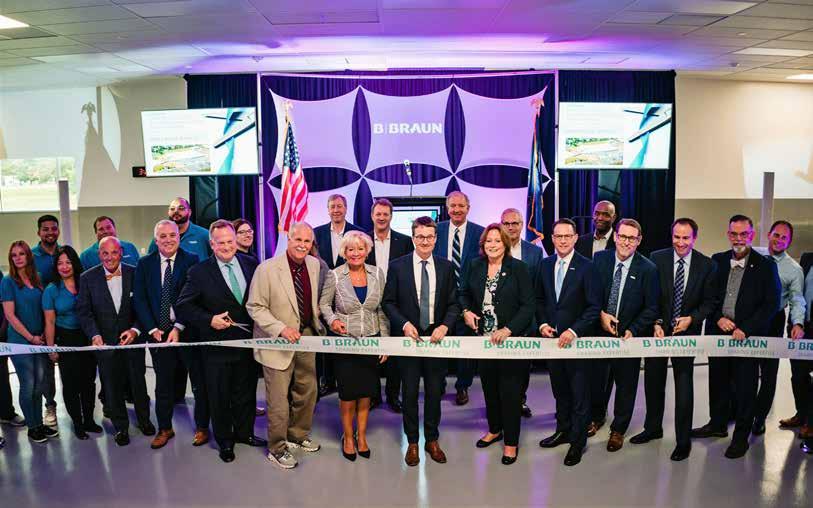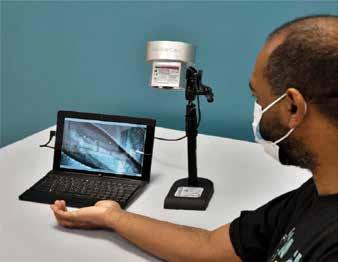
6 minute read
The medical device company invests to bring manufacturing closer to patients
The pandemic and the supply chain crisis exposed vulnerabilities in the healthcare supply chain during the past
three years as the U.S. was hit with shortages of critical therapies and medical supplies. International healthcare manufacturers with U.S. customers reassessed their strategies to become more resilient, and reshoring manufacturing back to North America became critical.
B. Braun, an international medical device maker with its global headquarters in Germany, has operated in the Lehigh Valley region of Pennsylvania since 1979. It opened its Allentown, Pennsylvania, campus in 1985 and recently expanded there with a more than $200 million, 310,000-square-foot addition. The expansion will add over 200 jobs to B. Braun’s existing 1,500 workforce in Allentown and aims to revolutionize manufacturing of medical devices, including life-sustaining infusion therapy devices to treat millions of patients in the U.S.
“Years before anyone heard of COVID-19 or the supply chain crisis, B. Braun made a commitment to expand its manufacturing capacity in the U.S. by investing more than $1 billion in new and modernized production facilities,” said Jean-Claude Dubacher, chairman and CEO of B. Braun of America Inc., in a statement. “The purpose was to increase the production of healthcare products needed to deliver critical care to patients in the U.S., to keep our manufacturing operations close to our customers and to reduce the potential for future supply disruptions that could put patients at risk.”
U.S. plant commitments
B. Braun’s U.S. commitments were seen across five states – Pennsylvania, Florida, California, Arizona and Texas – as well as in the Dominican Republic.
The recent Pennsylvania expansion nearly doubles B. Braun’s footprint in Allentown, and it includes state-of-the-art digitalization and automation technologies to improve efficiencies and connect all production steps and business processes.
“It will be the medical device plant of the future,” Dubacher said.
In Florida, B. Braun recently opened a 218,000-square-foot pharmaceutical manufacturing facility in Daytona Beach. It helps fulfill the manufacturer’s commitment to alleviate intravenous (IV) fluid shortages that have recently disrupted basic medical care delivery in the U.S.
B. Braun’s operations in California have expanded and modernized in recent years, including its pharmaceutical manufacturing plant in Irvine. These investments increase and improve the security supply of IV solutions, premixed drugs, antibiotics and nutrition products in strong demand by hospitals and healthcare facilities across the U.S.
Its CAPS® business in Arizona – Central Admixture Pharmacy Services Inc. – has significantly expanded the company’s ability to meet hospital needs for high-quality, safe and readily available sterile compounding drugs, many of which have been in short supply. A 250,000-square-foot 503B sterile compounding outsourcing facility has been recently completed in Phoenix.
And in Texas, B. Braun’s operations in Carrollton are growing. They include investments to modernize and expand the manufacturing and service of automated infusion and pharmacy compounding systems used by U.S. health systems. in Pennsylvania with the Pennsylvania Department of Community & Economic Development, Lehigh Valley Economic Development Corp., Pennsylvania Apprenticeship & Training Office and Workforce Board Lehigh Valley. And it’s collaborating with other manufacturers like OraSure, Lutron and Crayola to create a region-wide apprenticeship program that will provide career
STEM education commitments
“We’re incorporating the latest digitalization and automation technologies to operate these smart factories,” Dubacher said. “We need highly skilled craftspeople and technicians. So, we’re investing in our people and partnering with community colleges and technical training schools to improve mechatronics offerings.”
B. Braun is also expanding its apprenticeship programs and promoting STEM education – Science, Technology, Engineering and Mathematics – through schools and nonprofit organizations. It has partnerships opportunities for students across the Lehigh Valley region.
“These investments are the building blocks of healthcare in the U.S.,” Dubacher said. “They show that manufacturing in America is alive and well. Most of all, they represent B. Braun’s promise that we will be there for healthcare providers and the millions of patients who depend on our products.”
B. Braun has also recently celebrated the latest expansion of its medical device manufacturing plant in the Dominican Republic. That also allows the manufacturer to increase capacity to manufacture critical IV therapy products and keep the supply chain close to its U.S. customers.
“These investments weren’t easy, especially in the middle of a pandemic, but B. Braun followed through on these commitments and we’re seeing the results emerge across the country,” Dubacher concluded.
The Next Level of Vein-Finding and Vein Visualization
How doctors, nurses, EMTs and other caregivers can save lives, time and money by establishing IV access using Near Infrared Imaging’s new Vein-Eye Carry.
MedPro, the nation’s leading contract medical sales organization, recently partnered with Near Infrared Imaging (NII) to bring their Vein-Eye Carry device to both the acute and non-acute markets across the USA.
The Vein-Eye Carry provides practitioners of all types with an innovative solution for non-contact vein recognition.
With 40M vein punctures worldwide daily, it comes as no surprise that the ability to find veins accurately and thus provide timely, effective care is essential to the workflows, efficiencies, and life-saving capabilities of medical facilities of all types. Yet consider these rates of failure on the first attempt: ʯ 20% of adult vein punctures ʯ 30% of pediatric vein punctures ʯ 40% of critically ill patients ʯ 67% of IVs infusions fail, requiring moving the catheter or IV bag

These shockingly high rates of failure can be significantly decreased with the use of Vein-Eye Carry. Utilizing NII’s patented vein illumination technology in a device designed with practicality, ease-of-use and versatility in mind, Vein-Eye Carry uses cutting edge technology that enables caregivers to identify, locate and puncture veins with incredible proficiency. It provides images of veins in every patient, including the most difficult patients, and can easily be carried into the home or placed in an ambulance. It can identify infiltration and extravasation during infusion, as well as provide depth and size information of the veins. Plus, only the Vein-Eye Carry provides FHD (1920 X 1080) video of subdermal veins.
Weighing just 5 pounds when assembled, Vein-Eye Carry is also easy to transport – one small screen and a gooseneck imaging camera, both of which fit into a briefcase-sized carrying case – and can be used in myriad treatment settings. The camera easily attaches to medical furniture, IV carts, and wheelchairs, and is ideal for use in ambulances and evac vehicles as well. From hospitals to home health, ambulances to physician offices, and off-the-grid care centers, Vein-Eye Carry improves the level of care in any environment.
The home infusion industry is expected to grow from $31.0 billion to $61.7 billion by 2030. Eventually, the Vein-Eye Carry will become the gold standard for use in finding and illuminating veins.
While MedPro represents a number of globally recognized medical manufacturers, the contract sales company is also constantly looking to the future and striving to find innovative products that will transform modern healthcare. “We couldn’t be more excited to partner with Vein-Eye Carry,” states Bill Sparks, Founder & CEO of MedPro, “as we recognize the uniqueness of this device that has so many practical uses in such a wide variety of care settings. This product is at the forefront of advancements in healthcare technology, and we look forward to providing caregivers with its versatility and problem-solving capabilities.”
Accuracy, efficiency & comfort. By drastically improving the success rate of vein identification and puncture, Vein-Eye Carry increases efficiency, decreases costs, and enhances patient comfort.
Mobility, versatility & ease-of-use. Vein-Eye Carry is portable, lightweight, and can be used in virtually all healthcare settings with only hours of hands-on training for caregivers.









